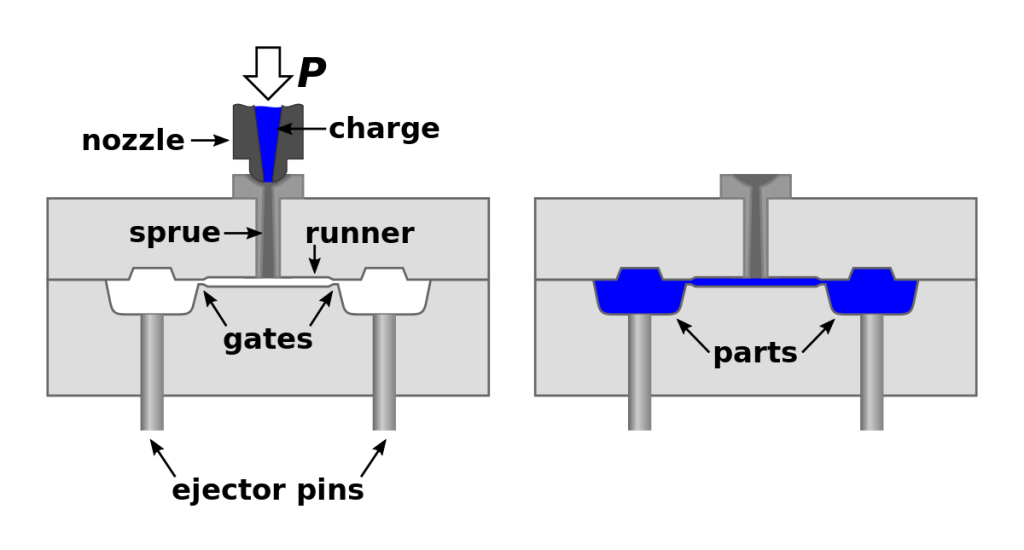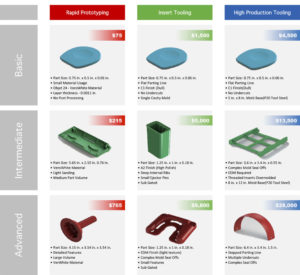Table of Contents
Injection molding is a widely-used manufacturing process that involves injecting molten material into a mold cavity. This process is commonly used to produce plastic parts, but can also be used for other materials such as metals and ceramics. It is a highly efficient and cost-effective method for mass production, making it a popular choice among manufacturers.
The process of injection molding involves several steps, including the melting of the material, injection into the mold, and cooling and solidification. It requires precision and careful attention to detail to ensure that the final product meets the desired specifications. Understanding how injection molding works can help you appreciate the complexity of the process and its importance in modern manufacturing.
How Does Injection Molding Work?
Injection molding is a popular manufacturing process used to produce a wide range of plastic products. It is a highly efficient and cost-effective method used in industries such as automotive, medical, and consumer goods. In this article, we will explore the process of injection molding in detail and understand how it works.
What Is Injection Molding?
Injection molding is a manufacturing process that involves injecting molten plastic material into a mold cavity. The material is then cooled and solidified to create the desired shape. The process is automated and can produce high volumes of products with consistent quality.
To begin the process, the plastic material is melted in a heated barrel and injected into the mold through a nozzle. The mold is typically made of two halves that are clamped together during the injection process. Once the plastic is injected into the mold, it is left to cool and solidify before the mold is opened, and the product is ejected.
The Injection Molding Process
The injection molding process can be broken down into several steps:
1. Clamping: The mold is closed and held under pressure.
2. Injection: The molten plastic is injected into the mold cavity.
3. Cooling: The plastic is left to cool and solidify.
4. Ejection: The mold is opened, and the product is ejected.
During the injection stage, the plastic material is forced into the mold at high pressure and speed. The mold is kept at a specific temperature to ensure that the plastic material cools and solidifies evenly. Once the plastic has cooled and solidified, the mold is opened, and the product is ejected.
Types of Injection Molding
There are several types of injection molding methods used in the industry, including:
1. Conventional injection molding: The most common method that uses a single mold cavity.
2. Multi-cavity injection molding: Allows multiple identical parts to be produced in a single cycle.
3. Insert injection molding: Used to insert metal or plastic parts into the product during the molding process.
4. Overmolding: Uses two different materials to create a product with two different colors or textures.
Benefits of Injection Molding
Injection molding offers several benefits for manufacturers, including:
1. High volume production: Injection molding can produce large quantities of products quickly and efficiently.
2. Consistent quality: The automated process ensures that each product is identical.
3. Cost-effective: Injection molding is a cost-effective method for producing plastic products.
4. Versatility: Injection molding can produce products of various shapes and sizes.
Injection Molding vs. Other Manufacturing Processes
Injection molding is not the only manufacturing process used to produce plastic products. Other methods include:
1. Blow molding: Used to produce hollow plastic products.
2. Thermoforming: Used to create products from flat sheets of plastic.
3. Rotational molding: Used to create large, hollow plastic products.
While each method has its advantages, injection molding is the preferred method for high-volume production of plastic products due to its efficiency and consistency.
Conclusion
Injection molding is a highly efficient and widely used manufacturing process that has revolutionized the production of plastic products. Its benefits include high-volume production, consistent quality, cost-effectiveness, and versatility. By understanding the injection molding process, manufacturers can produce high-quality plastic products efficiently and effectively.
Frequently Asked Questions
Injection molding is a manufacturing process that is widely used to produce a variety of plastic parts. It involves injecting molten plastic material into a mold to create a specific shape or design. Here are some commonly asked questions about how injection molding works.
How does injection molding work?
Injection molding is a process that involves melting plastic pellets or granules and then injecting them into a mold. The mold is made of two halves that are clamped together to form a cavity. The melted plastic is injected into the cavity under high pressure and fills the space between the two halves of the mold.
Once the plastic cools and hardens, the two halves of the mold are separated, and the finished part is ejected. Injection molding is a highly repeatable process that can produce large quantities of identical parts. It is used to create a wide range of products, from small components to large automotive parts.
What materials can be used in injection molding?
Injection molding can be used with a wide range of materials, including thermoplastics, thermosets, and elastomers. Some of the most common materials used in injection molding include polypropylene, polystyrene, and polyethylene. These materials are chosen for their properties, such as strength, flexibility, and resistance to heat and chemicals.
Other materials that can be used in injection molding include nylon, acrylic, and PVC. The choice of material depends on the requirements of the final product, such as its intended use, durability, and appearance.
What are the advantages of injection molding?
Injection molding has several advantages over other manufacturing processes. One of the main advantages is its ability to produce large quantities of identical parts quickly and efficiently. Injection molding is also a highly precise process, which means that it can produce parts with very tight tolerances.
Additionally, injection molding is a cost-effective process, especially for large production runs. It also allows for a high degree of customization, as the mold can be designed to produce parts with specific shapes, sizes, and features.
How is the mold designed for injection molding?
The mold for injection molding is typically designed using computer-aided design (CAD) software. The mold designer creates a 3D model of the part that is to be produced, and then designs the mold around that model. The mold is made up of two halves, which are designed to fit together precisely.
The mold designer must take into account factors such as the material that will be used, the required tolerances, and any special features that the part may require. Once the mold design is finalized, it is sent to a mold maker who will create the mold using a variety of tools and techniques, such as CNC machining and EDM.
What are some common applications of injection molding?
Injection molding is used to produce a wide range of products, from small components to large items such as automotive parts. Some common applications of injection molding include the production of toys, household goods, medical devices, and electronic components.
Injection molding is also used in the manufacturing of packaging materials, such as plastic bottles and containers. It is a versatile process that can be used to create products in a wide range of shapes, sizes, and colors.
In conclusion, injection molding is a complex and fascinating process that has revolutionized the manufacturing industry. With its ability to produce high-quality and precise parts at a rapid pace, injection molding has become a popular choice for a wide range of industries, including automotive, medical, and consumer goods.
One of the key benefits of injection molding is its versatility. The process can be used to produce a wide range of parts, from small and intricate components to large and complex structures. This makes it an ideal choice for manufacturers who need to produce a variety of parts quickly and efficiently.
Overall, injection molding is a critical process that has played a significant role in shaping the modern manufacturing landscape. As technology continues to advance, it’s likely that injection molding will only become more advanced and efficient, helping manufacturers to produce high-quality parts at an even faster pace.
Request a quote today!
[contact-form-7 id="1578" title="Contact form"]
Please compress the file into a ZIP or RAR file before uploading. Alternatively, send through your RFQ by email.
enquires@unitymanufacture.com





